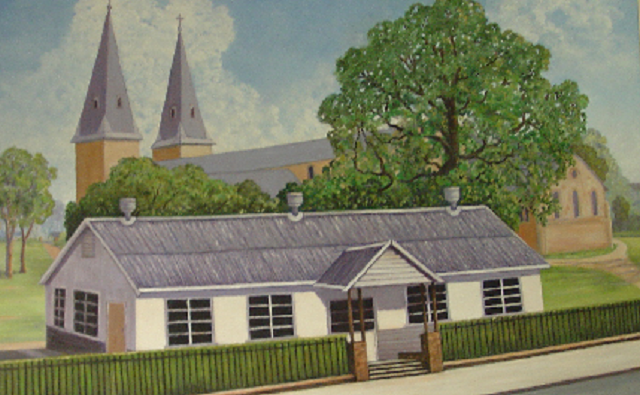
During World War Two, community organisations and local councils across Australia were instrumental in providing recreational opportunities in support of the physical and mental wellbeing of the transient population of service personnel who were stationed in or passing through their area.
For five years the building known as The Parramatta Soldiers’ Hut provided a welcoming and homely ‘drop in’ centre providing meals, activities and camaraderie for members of the allied forces.
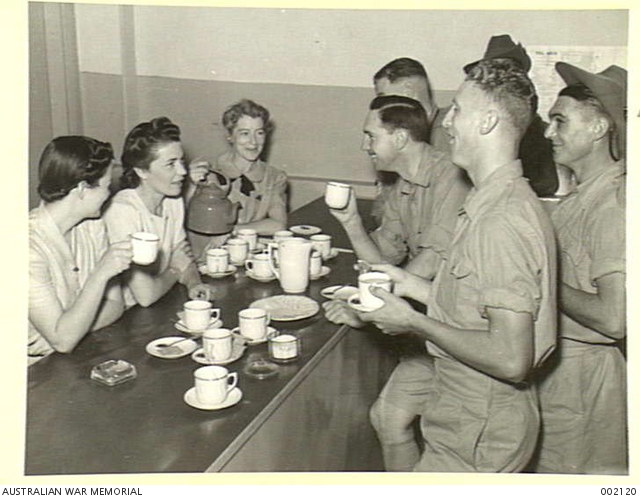
The Parramatta Hut was located adjacent to St John’s Anglican Church in Church Street in close proximity to both the Lancer Barracks and the railway station. After the idea of the Hut had been mooted by the Parramatta Mayoral Patriotic Committee, there was a great deal of enthusiasm and offers of support for the project. In July 1940, the Mayor, Ald Jeffery reported to the committee that Bishop Hilliard of St John’s Church had stated that there would be no difficulty in having a portion of the property made available for the construction of the Hut [1].
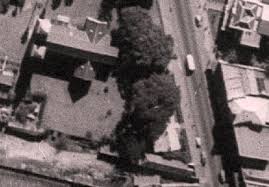
Bishop Hilliard outlined a series of conditions underwhich the church would agree to the erection of the Hut. The church was to be represented on the controlling committee, intoxicating liquor was banned and the building was to be removed after the war and a representative committee of ladies was to be appointed to operate facilities at the Hut [2].
Planning for the operation of the Hut did not always run smoothly. There was some consternation expressed by Mrs C G Berge, secretary of the Ladies Auxiliary of the Mayoral Patriotic Society (LAMPS) when the Parramatta Mayoral Patriotic Committee selected the women who were to run the Hut rather than consulting a cross-section of women’s organisations in Parramatta [3].
Designer of the building, Mrs L J Buckland estimated the costs to be about £850 for materials and £150 for labour. Ald Jeffery considered that the main concern was the cost of materials as labour for the project could be easily provided [4].
At the meeting of Parramatta City Council on 8 October 1940 the Mayor asked that building materials be supplied for the Hut through Council at cost price. This motion was passed by the meeting [5]. At a subsequent meeting on 21 October 1940, the Mayor reported that the sum of £370 had already been raised [6].

The local community had rallied behind the cause. In October 1940 students from Stott’s Parramatta Business College decided to collect ‘a mile of pennies’ in aid of the Hut. Girls from the college collected donations at various locations around the city and Keith Houison had made a ‘barometer’ to display a record of their takings [7].
John Shorter of Parramatta donated a billiard table for the Hut and calls were put out in local newspapers for a set of balls to go with the table. Industries in the Parramatta area donated construction materials. Malleys Limited provided the gutters and downpipes, Fowlers Limited the sanitary ware, Wesco Kalsomine Co the Cemco sheeting for the walls and roof and Australian Gas Light Company loaned a hot water system [8].
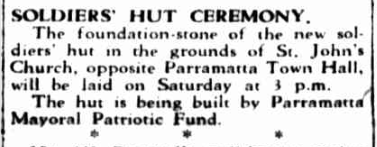
The foundation stone for the Soldiers’ Hut was laid on Saturday 18 October 1940 [9] and by the end of November 1940 the building was completed and ready for use.
The official opening ceremony was held on 29 November at 3pm and was preceded by public inspection of the facilities on the previous Tuesday and Wednesday. Admission was by donation of commodities such as tea, flour, sugar, matches, jam, tinned fruit, tomato sauce, coffee, table salt, pepper and mustard [10]. The Hut was opened by Lieut-General G N Miles, C M G, D S PO, General Officer Commanding Eastern Command [11].
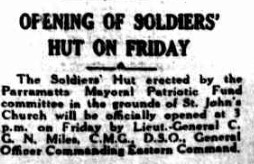
Members of the Parramatta Branch of the Women’s Australian National Service (WANS) which was formed to provide community service and employment roles traditionally filled by men, regularly staffed the Hut [12] as did members of the Country Women’s Association.
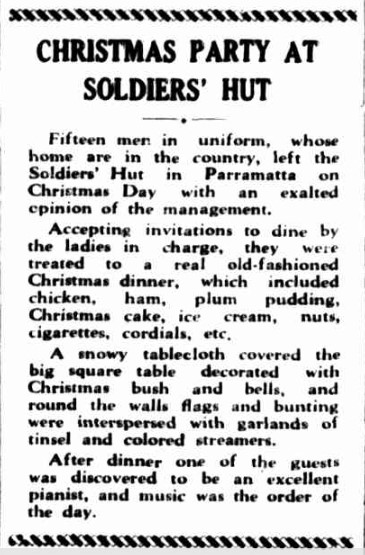
On Christmas Day 1940 the Hut was home for fifteen servicemen from country NSW who were unable to return to their families for Christmas. The soldiers were treated to an ‘old fashioned’ Christmas dinner including chicken, ham, plum pudding, ice cream, nuts, cigarettes, and cordial [13].
For the duration of the operation of the Hut the community continued to raise funds and donate resources. Proceeds from the annual ball of the company Howard Cultivators Ltd held in September 1942 was donated to the running costs of the Hut [14].
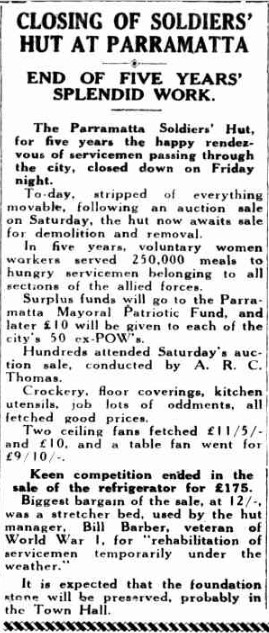
The welcome news of the surrender of Japan in September 1945 signifying the end of the war also meant the closure of the Soldiers’ Hut. Over the past five years the voluntary women workers staffing the Hut had provided over 250,000 meals to all sections of the allied forces. An auction sale of the contents including crockery, floor coverings, kitchen utensils and refrigerator was conducted by A R C Thomas. The sum of 12 shillings was fetched for a stretcher bed which had been used for the ‘rehabilitation of servicemen temporarily under the weather’ [15].
In February 1946, workmen commenced preparing the building for transportation to Westmead to fulfill the new function of church hall for St Barnabas’ Anglican Church, Westmead [16].
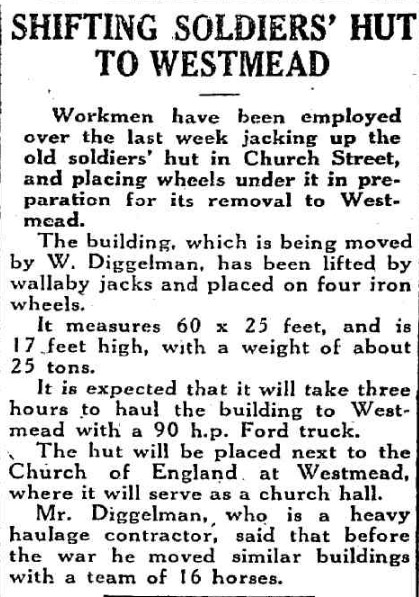
The structure weighing about 25 tons was lifted by wallaby jacks and placed on four iron wheels before being hauled by a 90hp Ford truck. The contractor, W Diggelman had previously used a team of 16 horses to pull heavy loads [17].
In March 1946, early morning crowds on their way to work witnessed an unusual phenomenon as the 25-ton Hut was moved through the streets on its way to Westmead. At one stage the building completely blocked Macquarie Street in the centre of Parramatta. The building safely reached its destination about 11.30am that morning [18].
The former Soldiers’ Hut from Parramatta still stands in the church grounds at Westmead, serving as the church office, continuing its long history of service to the local community.
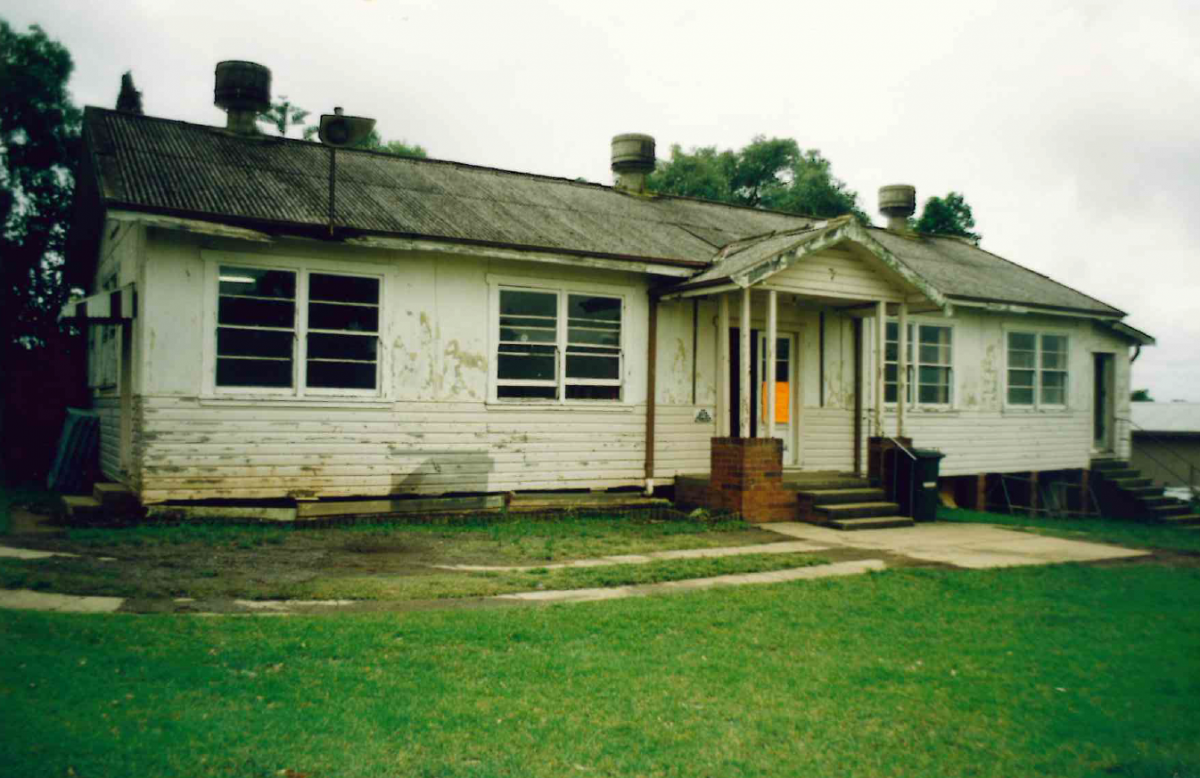
![]()
 Cathy McHardy, Research Assistant (with additional research by Michelle Goodman, Archivist and Lyndall Linaker, Research Assistant), City of Parramatta, Parramatta Heritage Centre, 2019
Cathy McHardy, Research Assistant (with additional research by Michelle Goodman, Archivist and Lyndall Linaker, Research Assistant), City of Parramatta, Parramatta Heritage Centre, 2019
References
- Soldiers’ Hut, offers of help. (1940, July 3). The Cumberland Argus and Fruitgrowers’ Advocate, p. 3. Retrieved 10/04/2018 from https://trove.nla.gov.au/newspaper/article/106205254
- Chewing gum too, parcels for Parramatta Soldiers – Welfare Hut. (1940, July, 17). The Cumberland Argus and Fruitgrowers’ Advocate, p. 1. Retrieved 10/04/2018 from https://trove.nla.gov.au/newspaper/article/106215892
- ‘Direct Action’: criticism of Soldiers’ Hut selection. (1940, July, 31). The Cumberland Argus and Fruitgrowers’ Advocate, p. 1. Retrieved 10/04/2018 from https://trove.nla.gov.au/newspaper/article/106198749
- £850 Estimate Soldiers’ Hut. (1940, August, 14). The Cumberland Argus and Fruitgrowers’ Advocate, p. 3. Retrieved 10/04/2018 from https://trove.nla.gov.au/newspaper/article/106210819
- Minutes of the meeting of the Parramatta City Council, 8 Oct 1940, p. 185.
- Minutes of the meeting of the Parramatta City Council, 21 Oct 1940 p. 194.
- Students to aid Hut fund. (1940, October, 2). The Cumberland Argus and Fruitgrowers’ Advocate, p. 3. Retrieved 10/04/2018 from https://trove.nla.gov.au/newspaper/article/106203976
- Soldiers’ Hut opening on November 29. (1940, November, 13). The Cumberland Argus and Fruitgrowers’ Advocate, p. 1. Retrieved 18/04/2018 from https://trove.nla.gov.au/newspaper/article/106209334
- Soldiers’ Hut ceremony. (1940, October, 16). The Cumberland Argus and Fruitgrowers’ Advocate, p. 1. Retrieved 18/04/2018 from https://trove.nla.gov.au/newspaper/article/106197923
- Soldiers’ Hut opening on November 29. (1940, November, 13). The Cumberland Argus and Fruitgrowers’ Advocate, p. 1. Retrieved 18/04/2018 from https://trove.nla.gov.au/newspaper/article/106209334
- Opening of Soldiers’ Hut on Friday. (1940, November 27). The Cumberland Argus and Fruitgrowers’ Advocate, p. 1. Retrieved 18/04/2018 from https://trove.nla.gov.au/newspaper/article/106214717
- W A N S notes. (1941, April, 30). The Cumberland Argus and Fruitgrowers’ Advocate, p. 5. Retrieved 18/04/2018 from https://trove.nla.gov.au/newspaper/page/9999066
- Christmas Party at Soldiers’ Hut. (1941 January, 8). The Cumberland Argus and Fruitgrowers’ Advocate, p. 5. Retrieved 10/04/2018 from https://trove.nla.gov.au/newspaper/article/107296523
- Social Jottings. (1942, September, 2). The Cumberland Argus and Fruitgrowers’ Advocate, p. 6. Retrieved 10/04/2018 from https://trove.nla.gov.au/newspaper/article/107291400
- Closing of Soldiers’ Hut at Parramatta: End of five years’ splendid work. (1945, December, 5). The Cumberland Argus and Fruitgrowers’ Advocate, p. 1. Retrieved 10/04/2018 from https://trove.nla.gov.au/newspaper/article/106125132
- Pulling down the Soldiers’ Hut. (1946, February, 27). The Cumberland Argus and Fruitgrowers’ Advocate, p. 1. Retrieved 18/04/2018 from https://trove.nla.gov.au/newspaper/article/105730846
- Shifting Soldiers’ Hut to Westmead. (1946, March 13). The Cumberland Argus and Fruitgrowers’ Advocate, p. 11. Retrieved 18/04/2018 from https://trove.nla.gov.au/newspaper/article/105733878
- Crowds see 25-ton Hut moved through street. (1946, March, 13). The Sun, p. 9. Retrieved 18/04/2018 from https://trove.nla.gov.au/newspaper/article/228794173


